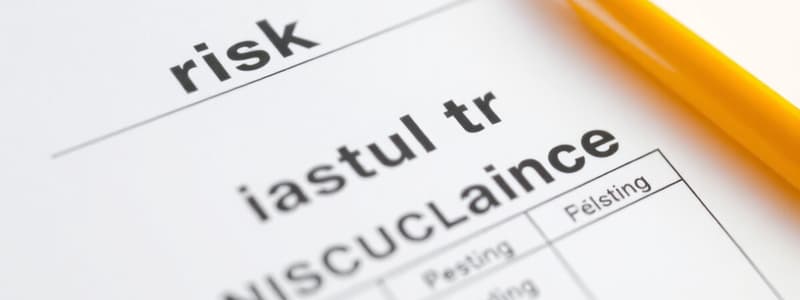Podcast
Questions and Answers
What is a calculated possibility of a negative outcome defined as?
What is a calculated possibility of a negative outcome defined as?
- Risk (correct)
- Hazard
- Peril
- Exposure
Which type of risk can result in both loss and gain?
Which type of risk can result in both loss and gain?
- Systemic risk
- Pure risk
- Speculative risk (correct)
- Diversifiable risk
What is the difference between peril and hazard?
What is the difference between peril and hazard?
- Peril and hazard are synonymous terms.
- Peril is a type of risk; hazard is never considered a risk.
- Peril causes loss; hazard increases the likelihood and severity of loss. (correct)
- Peril only refers to legal issues; hazard refers to physical conditions.
What type of risk affects the entire economy and cannot be reduced through diversification?
What type of risk affects the entire economy and cannot be reduced through diversification?
Which of the following is a technique of risk control focused on reducing frequency?
Which of the following is a technique of risk control focused on reducing frequency?
What does the frequency equation calculate?
What does the frequency equation calculate?
What is an example of moral hazard?
What is an example of moral hazard?
Which of the following risks includes the potential for business income loss due to physical damage?
Which of the following risks includes the potential for business income loss due to physical damage?
What is the characteristic of systemic risk?
What is the characteristic of systemic risk?
Which retention strategy involves knowingly choosing to keep some risks?
Which retention strategy involves knowingly choosing to keep some risks?
Flashcards
Risk
Risk
The possibility of a negative outcome, calculated based on the chance of it occurring.
Exposures
Exposures
Assets that could be lost or damaged.
Perils
Perils
Events that could cause a loss to your assets.
Risk Management
Risk Management
Signup and view all the flashcards
Pure Risk
Pure Risk
Signup and view all the flashcards
Speculative Risk
Speculative Risk
Signup and view all the flashcards
Diversifiable Risk
Diversifiable Risk
Signup and view all the flashcards
Non-Diversifiable Risk
Non-Diversifiable Risk
Signup and view all the flashcards
Enterprise Risk Management
Enterprise Risk Management
Signup and view all the flashcards
Systemic Risk
Systemic Risk
Signup and view all the flashcards
Study Notes
Risk Definition and Types
- Risk is a calculated possibility of a negative outcome.
- It's a probabilistic outcome (chance of loss, likelihood) that is known or estimated, ranging from 0 (impossible event, no risk) to 1 (certain event, no risk). 0.5 represents the highest risk (uncertain event).
- Frequency = number of losses / number of exposures
- Severity = total losses / number of losses
- Peril: the cause of a loss (e.g., fire)
- Hazard: a condition that increases the frequency and severity of a loss, but does not cause a loss itself (e.g., faulty wiring). Four types of hazards: physical, moral, morale, legal.
- Pure risk: either a loss or no loss (e.g., auto accident, flood).
- Speculative risk: loss, no loss, or gain (e.g., investment, gambling).
Risk Classifications
- Diversifiable risk: affects individuals or small groups, can be reduced/eliminated through diversification (multiple facilities, backups). Risks are not correlated.
- Non-diversifiable risk: affects entire economy/large groups, cannot be reduced through diversification. Risks are correlated. Government assistance may be needed.
- Enterprise risk: encompasses all major risks faced by a business. Includes pure risk, speculative risk, strategic risk, operational risk, financial risk.
Systemic Risk
- Systemic risk: the risk of collapse of an entire system or market due to failure of a single entity or group of entities. This instability can lead to the breakdown of the entire financial system.
Major Types of Pure Risk
- Personal risk: direct effect on individual or family, involving loss of income, extra expenses, and asset depletion. Perils include premature death, unemployment, disability/injury, and inadequate retirement income.
- Property risk: potential losses from destruction or theft of property.
- Direct loss: cost to repair or replace damaged property.
- Indirect loss: financial loss resulting from direct loss.
- Legal liability risk: financial consequences from injuries or damages caused to others. Includes defense costs, no cap on losses; liens can be placed on income or assets seized.
- Loss of business income: business interruption following physical damage, leading to loss of revenue.
Burden of Risk on Society
- Larger emergency funds are needed
- Loss of certain goods/services happens
- Worry and fear result
Risk Management Techniques
- Risk control: loss prevention (reducing frequency) and loss reduction (reducing severity).
- Risk financing: retention (retaining some or all losses), non-insurance risk transfer (contractual agreements, incorporation), insurance (transferring risk to an insurer).
Cyber Security
-
Cyber security is mentioned as an important risk.
-
Insurance- pooling of losses by transfer of risks to insurers who agree to indemnify insureds for losses
- accidental losses, agree to compensate for losses, provide monetary benefits on occurrence of loss
Basic Characteristics of Insurance
-
pooling of losses
-
spreading of losses incurred by a few over the entire group
-
purpose is to reduce variation (standard deviation), reducing uncertainty and risk
-
standard deviation- the average distance from the mean
-
-
payment of fortuitous losses
- fortuitous- unforeseen and unexpected by insured and occurs as result of chance
-
risk transfer
-
a pure risk is transferred from the insured to the insurer who typically is in stronger financial position
-
pure risk- can only result in loss or no loss (no opportunities for gain)
- Pure risk of loss can be transferred from one party to another party by contractual agreement.
-
-
indemnification
- the insured is restored to its approximate financial position prior to the occurrence of the loss
Law of large numbers
-
the greater number of exposures, the more closely the actual results approach probalble results expected
-
ex)flip a coin once, 50%/50%, flip it 10 times may be 80%/20%
Characteristics of an IDEALLY insurable risk
-
large number of exposure units
-
predict averages loss based on law of large numbers
-
large number of similar exposure units is needed
-
-
loss must be accidental and unintentional
- Law of Large numbers is based on randomness
-
loss must be determinable and measurable
-
determinable- did it occur?
-
measurable: amount of loss
-
-
loss should not be catastrophic to the insurer
-
allows pooling technique to work
-
solutions for insurers:
-
reinsurance
-
diversification
-
-
-
chance of loss must be calculable
- Must be able to calculate average frequency and average severity
-
premium must be economically feasible
- be able to afford the insurance
Adverse Selection
-
definition: tendency of a persons with higher than average chance of loss to seek insurance at average rates,
-
if not controlled by underwriting, results in higher than expected loss levels
-
results from asymmetric formation- when one party has info that is relevant to a transaction that the other party does not have
Underwriting risks
-
Definition: Processes of selecting and classifying applicants for insurance
-
make sure standards met
-
coverage terms/exclusions to consider
-
rates
-
-
underwriters for an insurance company
Types of insurance
-
private insurance-
-
life and health, property and liability (casualty)
-
life insurance- when dies
-
health insurance- when sick or injured (non-work related injuries)
-
property insurance
-
liability insurance- legal liability from property damage or bodily injury to others
-
casualty insurance- whatever is not covered my fire, marine, and life insurance. includes auto, liability, and workers compensation
-
-
categories of property and liability insurance
- personal lines, commercial lines,
-
government insurance- social insurance programs
-
social insurance programs
-
financed entirely or in large by contribution from emplyers and employees
-
benefits are heavily weighted in favor of low income groups
-
eligibility and benefits by statute
-
ex) social security, unemployment, medicare
-
-
other government insurance programs
-
both federal and state level
-
FDIC, FAIR, NFIP etc
-
-
Studying That Suits You
Use AI to generate personalized quizzes and flashcards to suit your learning preferences.




